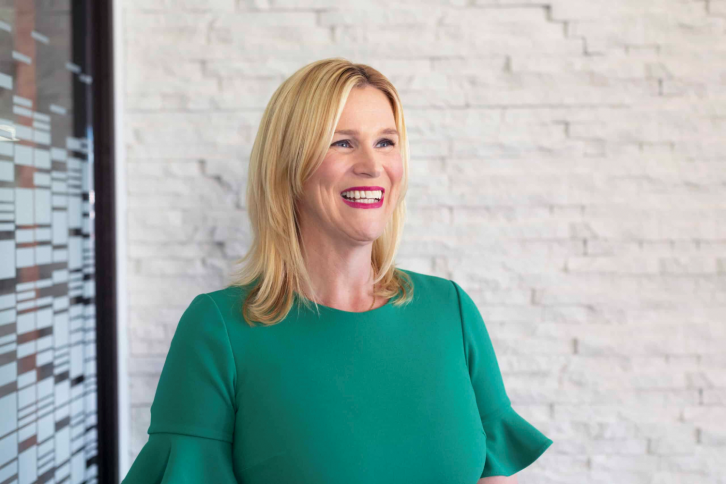From a childhood fascination to a pull towards translational medicine, who is this week's Woman in Science?

Could you give us an overview of your work?
I am the chief innovation officer at Maravai Life Sciences, the parent company to several life science brands, including TriLink BioTechnologies, Alphazyme, and Cygnus Technologies. I direct the research and development focus for the company and lead where we should be going in the future. Altogether, we specialize in nucleic acid products and services, including enzyme development and biologics safety testing. Our work is focused on building holistic partnerships with therapeutic developers, helping them overcome manufacturing challenges to streamline and scale research through clinical trials to commercialization. We mostly support nucleic acid therapeutic developers focused on DNA or RNA but are now expanding into cell and gene therapy applications.
The COVID-19 pandemic was a massive inflection point for our work because of the immeasurable impact of the mRNA vaccines. How can we utilize mRNA outside of COVID-19? How should we be extending our reach in different areas? What other RNA molecules should we be prioritizing and incorporating into the therapeutics of the future? These are the types of questions we’re trying to answer through our work – It's an incredibly exciting and rewarding job to do.
When did you realize you were interested in science - as a young child/teen/older?
As a young child, I was very interested in the medical and science fields which made my educational path from secondary school to graduate school very simple. From the beginning, I was completely fascinated by how science was applied within a medical setting. How could theoretical learning be employed to improve people's lives? What started in my childhood as a pure fascination continued on into my career, where I've been so lucky to be able to push science forward and hopefully make an impact on patient lives.
Could you describe your personal journey bringing us to where you are now?
Springing from my passion for science and medicine at a very early age, I decided to study genetics at the University of Glasgow. After finishing my Bachelor's degree, I jumped at the opportunity to complete my PhD in molecular genetics, where I worked with animal models to act as surrogates for a human disease model. Though it was an incredible experience, I felt a pull toward more translational medicine so I could connect with actual patients. Chasing that instinct, I enrolled in a post-doctorate program at the University of California – San Diego, applying my work on animal disease models to human beings.
Moving across the world was an overwhelming, but incredibly rewarding experience. What began with a three-year student visa has turned into a 20-year tenure in San Diego. As I neared the end of my postdoc program, I felt I still wasn’t close enough to the clinical applications of my work. When I finished my post-doc program, I began a position as an entry-level bench scientist working on clinical trials for DNA-based systems and medicines at Inovio Pharmaceuticals. I joined when the company only had 15 employees, so I was able to wear a lot of different hats and be extremely involved in clinical development, the regulatory process, clinical application, manufacturing, and the CMC. I definitely wouldn't have had the opportunity to do so if I had gone into a bigger corporate structure. In my 15 years at Inovio, I rose from entry-level scientist to Senior Vice President of Research, saw two products go through phase three clinical trials, and was able to see how our development work at the lab bench directly impacted patients.
Reflecting, one of the most rewarding elements of my career was visiting clinical trial sites to speak with doctors and nurses, and then explain our technology to the patients. I give patients so much credit for enrolling in clinical trials – they show such passion, interest, and enthusiasm for therapeutic advancements that likely won’t make a direct difference to their lives but will for patients in the future. After my 15-year tenure, I joined Maravai to lead the research and development team. I saw this move as an exciting challenge to continue leading innovation and research but doing so for a different technology set – RNA rather than DNA.
What challenges did you face along the way and what is the most valuable lesson you have learned? What were some key lessons you learned from your experience supporting the global response to the COVID-19 pandemic?
I can’t emphasize enough the importance of doing work outside of your comfort zone. In my early days as a bench scientist, I was asked to support clinical development. Despite my lack of experience, rolling up my sleeves and learning on the spot helped expand my capabilities and allowed me to be the leader I am today. When you get an opportunity to learn something that isn't necessarily in your area of knowledge, jump at it!
One of the most pivotal learning moments of my career was my dual role in the global response to the COVID-19 pandemic. When the first cases were reported, I and a tour de force of scientists with completely different backgrounds worked together around the clock to create a safe, effective vaccine. In addition to that work, I was later requested to be a spokesperson responsible for communicating the COVID-19 vaccine progress and its science to the masses. My background is in infectious disease, not mass communications – this was completely out of my comfort zone. I spoke at the World Health Organization COVID-19 response meetings to relay clinical development updates and answer any questions. This experience proved how important it is for scientists to clearly communicate 1. what R&D teams are doing, 2. What mechanisms are involved, and 3. why we're doing it in specific ways. The majority of the population understandably doesn’t have 20 years of experience in life sciences. Making sure the advancements within our industry are available and easily interpreted by the wider population is the first step to the global understanding of the importance of science and therapeutic research and development.
What is your current work ethos/style?
Throughout my career, my work ethos has been rooted in communication. The continuous articulation and emphasis of the vision and value of a company’s work helps those from multifactorial backgrounds collectively push toward the same goal. At TriLink and Maravai, the R&D scientists are clearly aware of the internal product development and advances in the wider field. A crucial aspect of my role is distilling those updates to the majority of the team with less visibility, making sure we understand and leverage this excitement for mRNA advancements beyond COVID-19 vaccines. If your team can believe in the company’s work, they’ll be excited to come to work every day to push these new, exciting medicines forward.
What ignites your passion in your current role?
Right now, the future use of mRNA ignites my passion. A silver lining of the pandemic was the general public saw the power and potential of mRNA through the success of the COVID-19 vaccination. Now, we are able to expand into other capabilities. The standard of care for cancer treatment has been chemotherapy for a long time. There have been some recent immunotherapy advancements, but many patients will tell you it’s a painful treatment to experience. We are already seeing some impressive results from clinical trials for personalized mRNA cancer vaccines. The data we are seeing could entirely shift the paradigm of future cancer treatment.
I’m incredibly excited about the CRISPR approvals at the end of last year in the U.S. and Europe. Before then, there were no treatment options for thousands of monogenic diseases – only symptom management. This approval will open up the doors for the treatment of other devastating diseases such as Huntington's disease, cystic fibrosis, and more.
What most excites you about the future of this field? What roadblocks do you foresee?
In the next 15 years, medicine will evolve into a more personalized approach. With that said, there are challenges to face in the field of mRNA. For instance, the mRNA COVID-19 vaccine is delivered successfully in the body with a lipid nanoparticle (LNP), but that molecule targets only the liver. There are many diseases for which we want to target the heart, brain, skin, etc. Many companies are working to develop the delivery molecules for those specific areas.
Another roadblock is the instability of mRNA as a molecule. During the COVID-19 pandemic, there was a rush to get freezers in all doctor’s offices because the vaccines needed to be kept at a specific temperature. In medical centers and large metropolitan areas, we can have big -80 freezers. However, in a rural clinic or developing nations, accessibility becomes an issue. We need to increase mRNA’s stability, so it can be accessible beyond urban areas and developed countries.
Could you share some advice for young women starting to develop an interest in science or wanting to pursue a career like yours?
In 2024, women are almost 60% of life science graduates but only 20% of CEOs in life science companies. This lack of women rising to leadership positions is frustrating. As a mother of a young daughter, it's incredible that to this day, it's common that I'm the only woman in the room at a scientific meeting, and certainly the only female executive. I could bend your ear about how many times I've been the only woman in a room, and they’ve mistaken me as somebody who's there to take notes. I try to take it all with a sense of humor – getting angry won’t benefit me – and I make it my goal to prove my worth in that room. I do believe that over time we will see increased diversity within those settings.
If you are a young woman in STEM, continue to fill your network with mentors, both men and women, who have been in your shoes and can be sounding boards for your ideas.
If I could give advice to women, I would encourage them to pursue a career in STEM if it interests them. I'm quite actively involved in STEM for girls mentoring programs, and I’m humbled to work to ensure that those young women view STEM as a valid career path and that when they enter into the field, they have the support to learn and progress forward to the positions they want.








